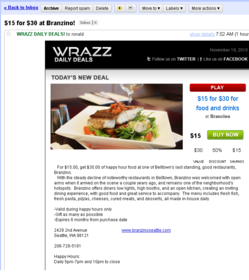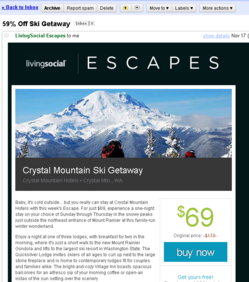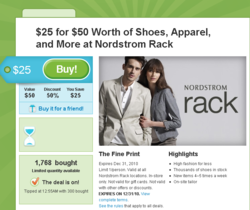 A similar version of this post appeas today on Crosscut.com.
A similar version of this post appeas today on Crosscut.com.
They're known, collectively, as social media coupons: Groupon, Goldstar, Living Social, Bogopod, Tippr, Gizmodo, Wrazz, DealPop and others. They offer a "deal," half off some product or service (often meals in a restaurant but it could be hats or haircuts, spa treatments or medical consultations), or free, if you get three or four of your friends to sign up with you.
Retailers--small, independent, not particularly skilled at numbers--jump at the chance to offer their products to a wider audience, but they're making a big mistake.
As consumers, we like the notion of a deal, of paying less than retail, of something for nothing. Our collective Puritan heritage of thrift has instilled in contemporary American culture a distaste for profligacy and virtually demands that we seek the lowest price. (Now, that doesn't mean we should dine-and-dash; we're still expected to pay up.) Even so, in jumping at the chance of getting something for next-to-nothing, we're only helping the merchants commit suicide.
 We have to assume that retail businesses price their goods and services accurately. That is, cost of goods (supplies, ingredients, whatever) plus overhead (labor, occupancy, administration) plus profit. Where's that 40 percent discount going to come from? Payroll? Rent? Even if you lose a couple of bucks on every transaction, you're not going to make it up on volume. If a neighbhood restaurant, day spa or boutique can show me that their 40 percent Groupon discount comes from a budgeted promotional campaign that's part of their budgeted admin expenses, well, I'll eat my hat. Otherwise, I have to assume that the original price was bogus.
We have to assume that retail businesses price their goods and services accurately. That is, cost of goods (supplies, ingredients, whatever) plus overhead (labor, occupancy, administration) plus profit. Where's that 40 percent discount going to come from? Payroll? Rent? Even if you lose a couple of bucks on every transaction, you're not going to make it up on volume. If a neighbhood restaurant, day spa or boutique can show me that their 40 percent Groupon discount comes from a budgeted promotional campaign that's part of their budgeted admin expenses, well, I'll eat my hat. Otherwise, I have to assume that the original price was bogus.
 The business model we've become used to is a relic of supermarket wars: the weekly specials, announced in vivid color every Tuesday. Buy one chicken, get a second chicken free. Hamburger, $1.29 a pound. A free bag of carrots. Yogurt, 4 for $1. Tuna, 50 cents a can. But we forget two important points. First, the average supermarket carries 50,000 items on its shelves, and discounting the price of a dozen or so best-sellers (carrots, chicken) is built into the budget. Second, the rest of the promotions in the weekly mailer (the yogurt, the tuna) are actually offered by the manufacturers or their distributors, and don't cost the store a dime. The point is to entice shoppers into QFC rather than Safeway, the fight is between half dozen supermarkets, not 4,000 restaurants. (Similarly, the Cascade yogurt guy's competition, once you're in the door at QFC, is Tillamook.)
The business model we've become used to is a relic of supermarket wars: the weekly specials, announced in vivid color every Tuesday. Buy one chicken, get a second chicken free. Hamburger, $1.29 a pound. A free bag of carrots. Yogurt, 4 for $1. Tuna, 50 cents a can. But we forget two important points. First, the average supermarket carries 50,000 items on its shelves, and discounting the price of a dozen or so best-sellers (carrots, chicken) is built into the budget. Second, the rest of the promotions in the weekly mailer (the yogurt, the tuna) are actually offered by the manufacturers or their distributors, and don't cost the store a dime. The point is to entice shoppers into QFC rather than Safeway, the fight is between half dozen supermarkets, not 4,000 restaurants. (Similarly, the Cascade yogurt guy's competition, once you're in the door at QFC, is Tillamook.)
Supermarkets have a captive market, and they know it. Their promotions aren't designed to help shoppers but to take business away from the competition. If the supermarket model were transformed to the world of restaurants, there'd be six restaurant chains in Seattle, plus maybe a few quirky, neighborhood burger bars, and they'd be the only places in town where you could buy anything to eat. Each restaurant would have 1,000 or more seats; there might be a weekly steak special for $5, but sides, drinks and dessert would be extra. Your tab, every time you sat down, would wind up the same, about $75, regardless of which restaurant you patronized or what you ate.
 Oh, but we just want people to come and try our pizza / burgers / spa treatment, the retailers say. To which I reply, recast this. they're really saying "We're so sure that our pizza, etc., is so fabulous that after you pay $10 the first time, you'll come back and pay $20." One more time: "We're going to train you to think that our $20 pizza is only worth $10." I call this the Happy Hour falacy.
Oh, but we just want people to come and try our pizza / burgers / spa treatment, the retailers say. To which I reply, recast this. they're really saying "We're so sure that our pizza, etc., is so fabulous that after you pay $10 the first time, you'll come back and pay $20." One more time: "We're going to train you to think that our $20 pizza is only worth $10." I call this the Happy Hour falacy.
Mark Netsch, who writes PerformanceScope, an industry newsletter, recalls going to a new wine bar in his neighborhood, lured by a Groupon discount. The staff was woefully unprepared. He wrote some advice to merchants, "Groupon and similar services are indeed a good way to bring in new customers. But before you Groupon ask yourself if you and your team are ready." Unless the restaurant is guest-ready to deliver on all its marketing promises and its brand's points of differentiation, Netsch warns, "You will undermine your mission. Redeeming 3,000 Groupons at 50 percent off is not the objective, converting those trials to loyal customers is."
Groupon boasts some 20 million bargain-hunting subscribers, and they pounce quickly. In Chicago, there's a two-year waiting list for merchants to get into a Groupon promotion. Portland recently, a neighborhood coffee shop called Posie's offered a $6 Groupon for a $13 item. A thousand people showed up, swamping the small shop for three months. In a blog post, the owner said that the volume of sales coupled with the steep discount threatened her business, forcing her to spend $8,000 of her personal savings to pay her employees and the rent. "The single worst decision I have ever made as a business owner thus far," she wrote. The true cost of a Groupon promotion is almost impossible to calculate. Here's the math.
Another misreading of discounts is to confuse lost capacity with lost opportunity. A cruise ship sails whether or not its 2,000 cabins are filled. One assumes that an analyst knows exactly how many full-price cabins are needed to cover operating costs, after which every additional passenger is "gravy," so you can, indeed, get space on some cruises for insanely little money. Fancy hotels are in a similar bind. Come 6 PM, they've probably run out of customers for the night, though they may not want to cheapen their brand by dropping their price too far. Airlines have similarly inflexible capacity, but they've mastered the art of flexible pricing; it's called "yield management," and it works. When's the last time you were on a flight with more than a couple of empty seats?
But a restaurant, oh my. Fifty seats, let's say, capacity of 100 dinners a night, 700 a week. Average check in Seattle these days, industry stats tell us, is $30. In theory, then, a modest restaurant could gross $3,000 a night, a million clams a year. Could, but, for whatever variety of reasons, doesn't come anywhere close. But Otto the Owner, he hears the siren song of coupons and makes a pact with the devil. "I'll gladly take an extra 200 clients a week," he thinks, and his fate is sealed. The 200 coupons spend $15 instead of $30 and tip like misers. It costs Otto ten bucks a plate to feed these mooches, who fill up tables and keep his kitchen busy, his servers frantic, and annoy the hell out of his regulars. But we're not done. Otto's gross is up slightly, true, but he had to add a cook and a server for the week of the promotion, he had to buy extra food for those 200 dinners, and he still has to pay the promoter for the coupon campaign. Otto didn't understand the costs involved; all he saw was empty tables. He was giving away the store, not realizing that the cheapskates who showed up with a coupon weren't the kind of customers he wanted in the first place.
Leigh Fatzinger, founder of Seattle-based Nology Media ("connecting brands with their audiences"), says the problem with online coupons is that they are sent to mass e-mail lists. "If you and your friends score a $400 dinner for $200, will you really come back at full price, when the merchant has to make a profit?"
Another online marketing guru Edward Nevraumont, over at Expedia.com, sees three issues for restaurants that use Groupon and its ilk. "Big volume spikes, lots of cannibalization, and brand dilution through discounting." It shows just how much restaurants need--or think they need--volume.
Enter a site called Restauranteers.com, going fully live in January, which promises an "opaque" model, in which the merchant controls the number of promotions that will be available on any given day. Capitol Hill's Thomas Street Bistro (five tables) needs to make sure they're filled, but would be nuts to offer the kind of coupons needed by, say, Cheesecake Factory (400 seats).
One recent coupon offer did make a certain kind of sense, to me at least: a limo rental. What better way to convince someone that a limo ride is really worth the $150 than to offer a trial run at half price? You don't confuse a limo ride with discount Mexican food. Yes, you essentially give away the store, but it's such a personalized luxury that a trial run stands a strong chance of resulting in repeat business.
 Repeat business is the key. It's what marketers call the lifetime value of a customer relationship. It's what the limo driver wants to build; it's what the clothing salesman at Nordstrom wants to build. Nordy runs the occasional sale, sure, but it doesn't send out 50-percent-off-coupons. (That's Nordstrom Rack, a discount store that feeds off the value of the company's name.) No, unbelievably, Nordstrom has trained its customers to pay more, because of the perceived value of customer service."They treat me with respect, and if it isn't right, I can always take it back." Ask 100 Seattle diners the name of the city's best restaurant, and more than half will tell you Canlis, even if they've never been there, because--regardless of price--its reputation for peerless service. To celebrate its 60th anniversary, Canlis didn't lower its prices; it did something much more sophisticated. It staged a treasure hunt that emphasized the low price of its 1950 menu.
Repeat business is the key. It's what marketers call the lifetime value of a customer relationship. It's what the limo driver wants to build; it's what the clothing salesman at Nordstrom wants to build. Nordy runs the occasional sale, sure, but it doesn't send out 50-percent-off-coupons. (That's Nordstrom Rack, a discount store that feeds off the value of the company's name.) No, unbelievably, Nordstrom has trained its customers to pay more, because of the perceived value of customer service."They treat me with respect, and if it isn't right, I can always take it back." Ask 100 Seattle diners the name of the city's best restaurant, and more than half will tell you Canlis, even if they've never been there, because--regardless of price--its reputation for peerless service. To celebrate its 60th anniversary, Canlis didn't lower its prices; it did something much more sophisticated. It staged a treasure hunt that emphasized the low price of its 1950 menu.
One wonders, why throw that investment in an existing customer relationship out the window by offering discounts to newbies who only want a cheap dinner? Take that promotional budget you were going to spend on social media coupons (or, for that matter, on Dine Around, or Restaurant Week) and spend it, instead, on your regular customers. Build a mailing list to track your customers, treat them like royalty when they visit, add back-of-house staff so the chef can spend time with the guests, or front-of-house staff so servers can take the time to cosset the guests. Do more for your existing customers, and convert them into ambassadors. Think like Nordstrom, think like Canlis.
Meantime, Groupon and its clones have taken hold; the battle for full-time, full-price pricing seems lost. According to the New York Times, Groupon has spurned a takeover offer of $6 billion from Google in favor of an IPO rumored to value the company at, ahem, $15 billion. That would represent a bet by investors that the lifetime customer value of Groupon is worth $100. Imagine! A company value that says every wired adult in America will buy from you several dozen times. Those are Apple-Miscrosoft-Google numbers, unsustainable for a company that offers no value of its own except access to a customer base. It is nothing short of delusional.
UPDATE Saturday, January 22nd: Google says it will launch a competing service called Offer.
Ronald, great article and thanks for all the fantastic research/links!
And, while I agree with a lot of what you say, I still think there's value for restaurants in this model. Restaurants are, after-all, still high fixed cost businesses...rent, equipment leases, marketing, insurance, and staff typically make up the vast majority of the cost structure.
Don't you think that IF restaurants limit the number of offers that these can be a good way to get diners to try out their business? Won't some be converted to loyal customers?
Are there other changes to the model that would make it work better? I'm not sure what it would be, but my sense is this approach is still new enough that we will see more innovation. Certainly the printed Yellow Pages are dead and they were a significant part of many restaurants' marketing budgets in days gone by.
Delighted to read this, Ronald. I've had a fairly difficult time articulately my concerns when I see our small, indie shops and restaurants dine up for Groupon. My assumption has been that they need a temporary hit of cash, so much so that they're willing to overlook the whole "giving away the store" problem with these deals. Sounds like for at least one Portland coffee shop, even that's not necessarily true.
Ron, you are "spot on" about the challenges for small businesses and the impact discounting can have. It can be devastating for a business. You and your readers may not be aware of the payment schedule and the offsets (credit card and a per purchase fees) Groupon requires of the merchant in addition to the dis...count. It lowers the margins for the business even more. Thank you for providing a "voice" for the restaurateur/small business that works hard to provide value for every dollar their customer spends. I have been blessed by wonderful clients who have enjoyed their experience in the kitchen and have driven my business by word of mouth. I couldn't possibly find enough dollars in a marketing budget to create that kind of reputation. So again thank you, for enlightening your readers about the true cost of discount purchasing and whether by using them you are helping to sustain and grow a dynamic, creative local food scene or unintentionally putting it at risk.
An excellent and timely article. There are so many of these daily deal sites springing up that it is all too easy to get swept away by blind enthusiasm and fail to understand the risks. Once a business has plunged in to the race to the bottom there is no going back. You cannot re-finish your brand once you've tarnished it.
Thanks for the article -- you are spot on! People don't realize it: owning a small business is everything but easy. I know a friend that was losing money for each discount he offered, but he hoped that in the end, the customer would come again -- which wasn't the case since he was unprepared.